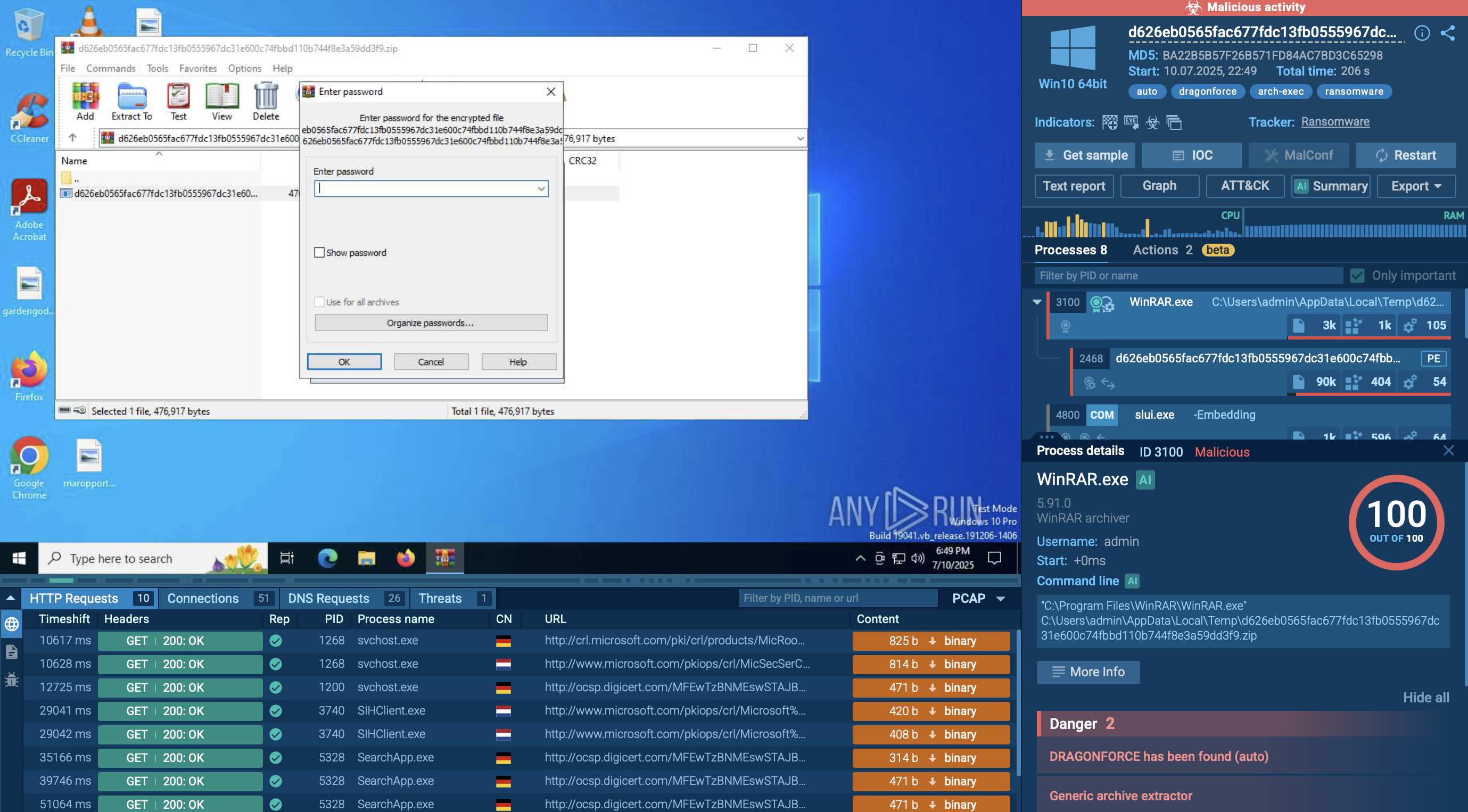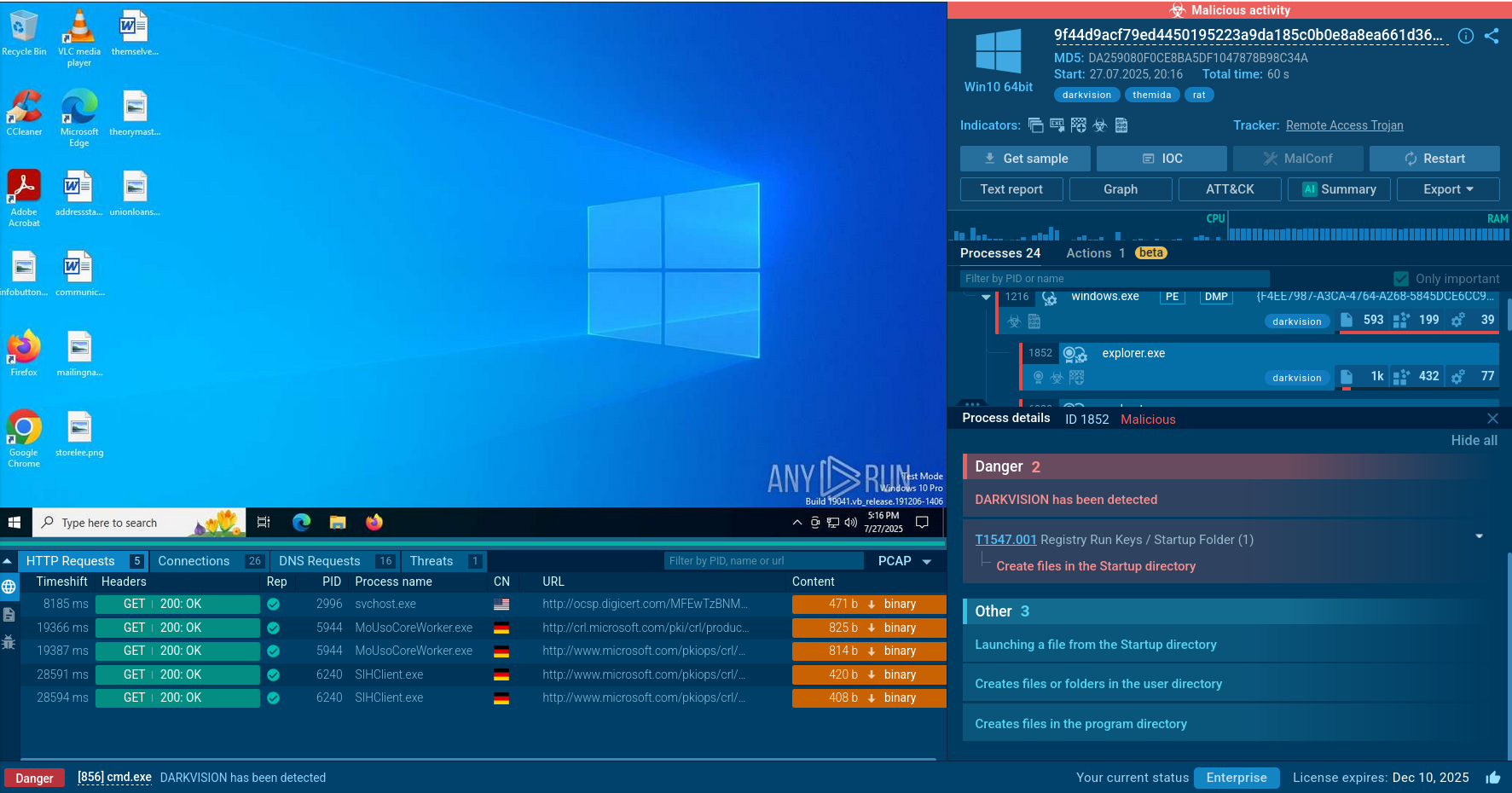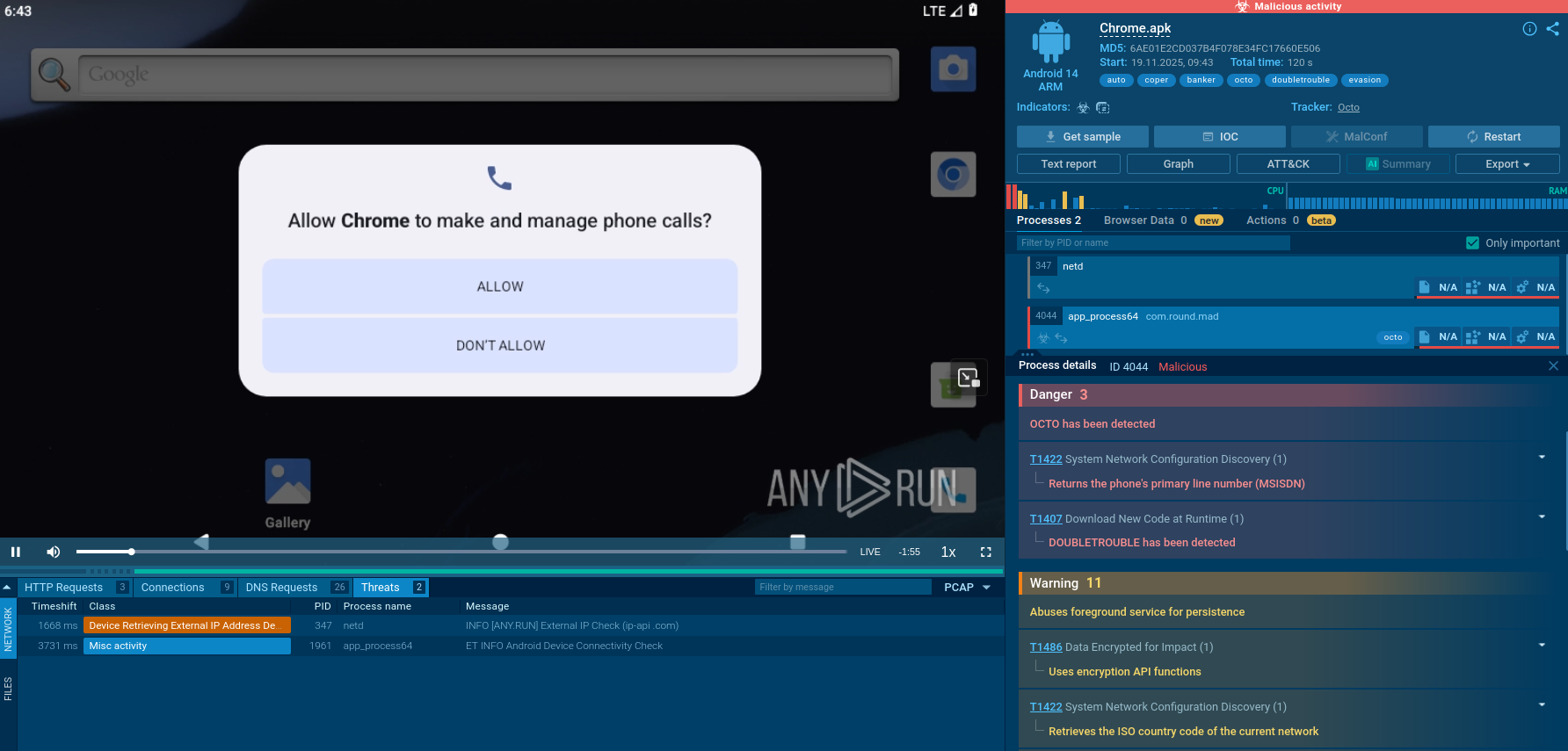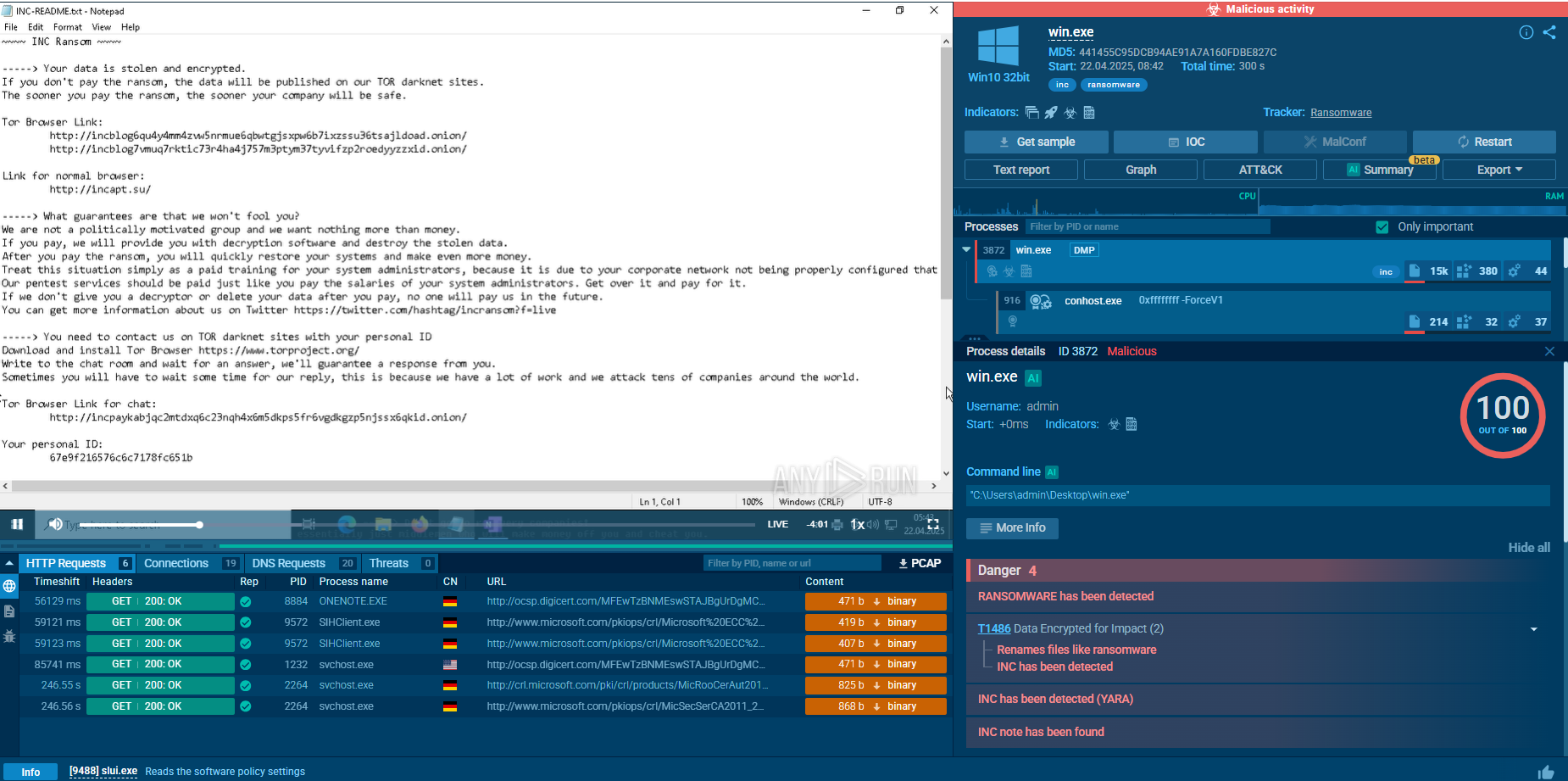Webinar
February 26
Better SOC with Interactive Sandbox
Practical Use Cases


Bert Ransomware is a newly emerged ransomware group that has been active since April 2025. It deploys variants targeting both Windows and Linux systems, focusing on critical sectors like healthcare, technology, and event services across the US, Asia, and Europe.
|
Ransomware
Type
:
|
Unknown
Origin
:
|
|
1 April, 2025
First seen
:
|
8 December, 2025
Last seen
:
|
|
Type
:
|
Unknown
Origin
:
|
|
1 April, 2025
First seen
:
|
8 December, 2025
Last seen
:
|

 121
121
 0
0

 268
268
 0
0
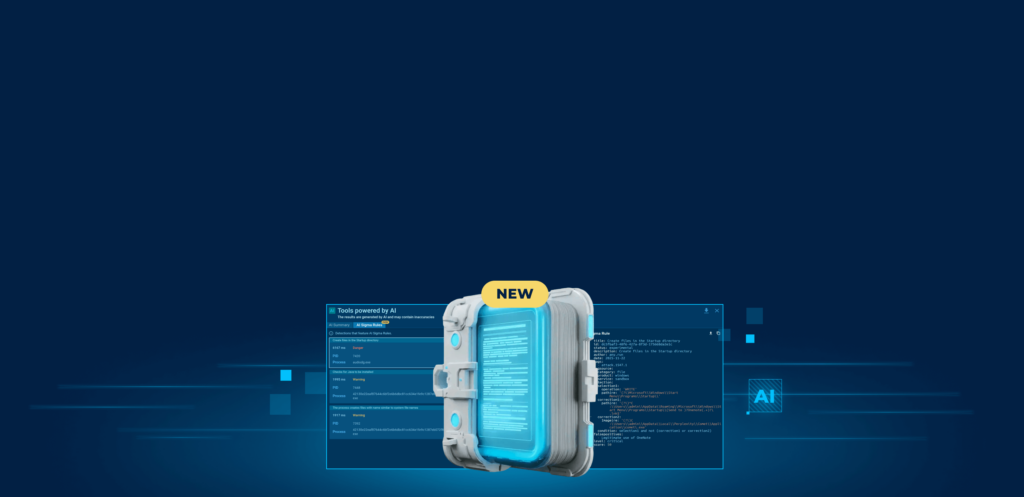
 4543
4543
 0
0
Observe Bert’s killchain, network connections, and processes in ANY.RUN’s Interactive Sandbox:
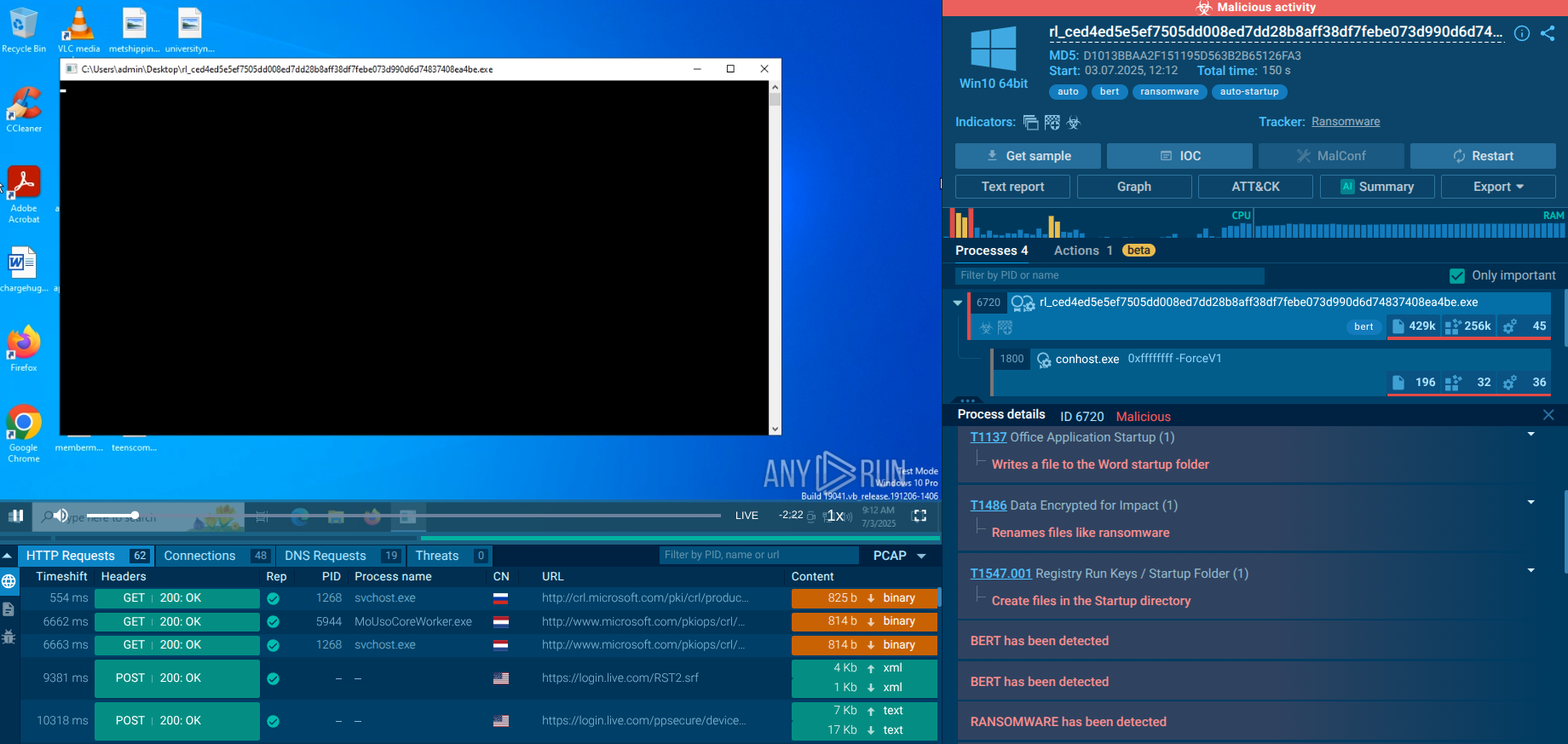 Bert Ransomware Windows variant detonated in Interactive Sandbox
Bert Ransomware Windows variant detonated in Interactive Sandbox
Use ANY.RUN’s Threat Intelligence Lookup to gather and explore Bert’s IOCs and TTPs:
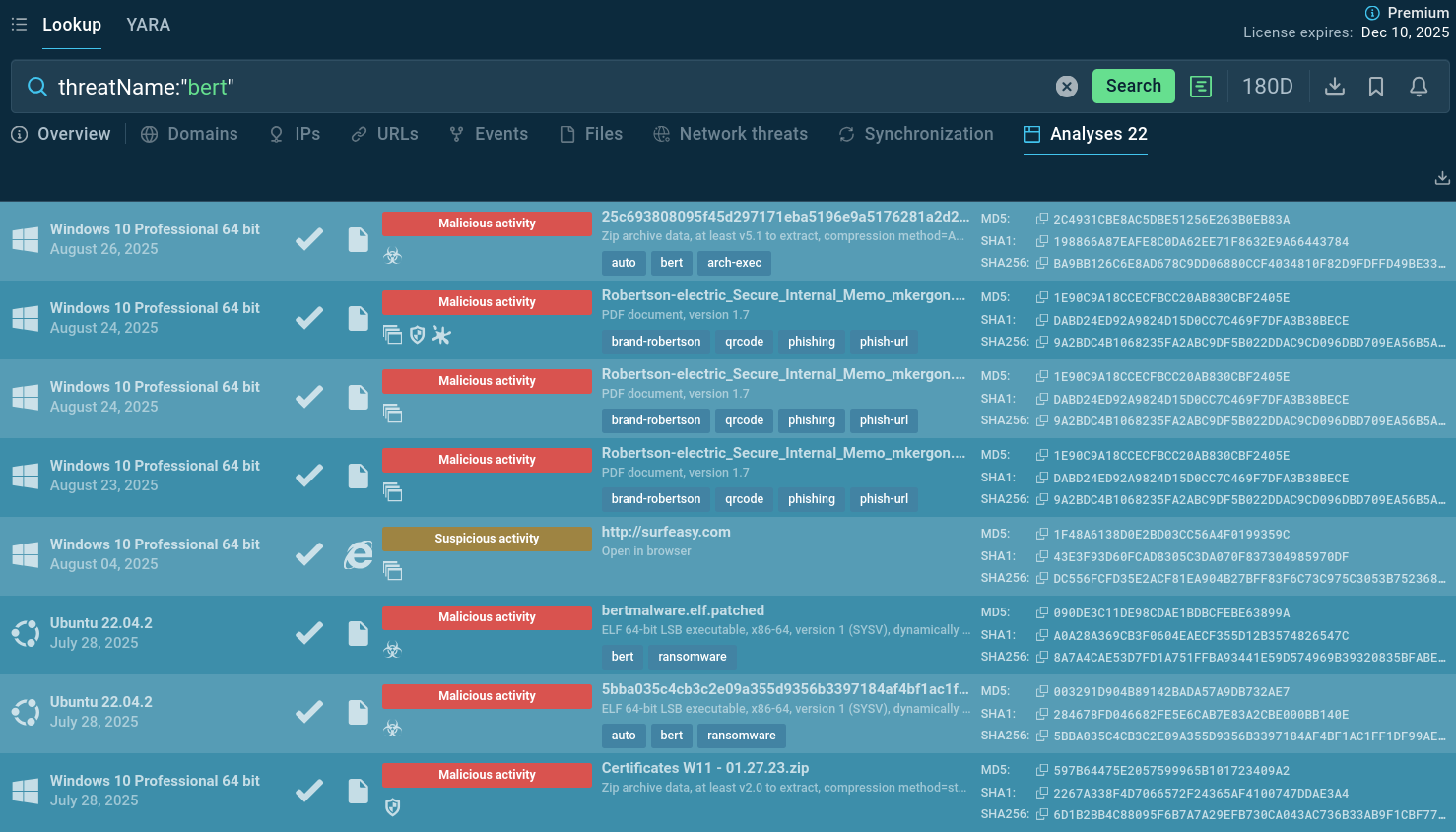 Bert samples found via TI Lookup: watch behavior, gather indicators
Bert samples found via TI Lookup: watch behavior, gather indicators
BERT ransomware distinguishes itself through its multi-platform capabilities and streamlined attack execution. Bert has been observed targeting organizations since April 2025, with confirmed victims in sectors including healthcare, technology and event services. The ransomware group operates with a sophisticated approach that belies its relatively simple code structure, demonstrating how modern cybercriminals can achieve maximum impact with efficient tools.
An analysis of an infection of a Windows system found that the variant used a straightforward code structure, with specific strings to match and terminate certain processes. Files were encrypted using the standard AES algorithm. The public key, file extension, and ransom note were easily accessible. This approach allows for rapid deployment while maintaining strong encryption capabilities that make data recovery without payment extremely difficult.
The ransomware is cross-platform, with Windows variants using PowerShell loaders for initial execution and Linux variants optimized for server environments like VMware ESXi. Bert's operations blend traditional encryption with advanced evasion techniques, such as multi-threaded processing for speed and targeted shutdowns of virtual machines.
By July 2025, multiple iterations have been observed, including updates to encryption libraries and command-line flags, highlighting the group's adaptability. Unlike more sophisticated actors, Bert prioritizes speed over stealth — encrypting files as they are discovered rather than pre-scanning — making it a growing concern for hybrid IT environments.
Bert has a modular structure: it can integrate with other malware loaders and is often distributed through phishing emails, malicious attachments, and compromised remote desktop protocol (RDP) access. This adaptability makes it dangerous for businesses across different sectors.
Multiple infection vectors include:
The group's victim selection appears strategic, focusing on organizations that are likely to pay ransoms quickly due to the critical nature of their operations.
Primary target sectors include:
Geographically, Bert ransomware has demonstrated global reach with confirmed attacks across Asia, Europe, and the United States. The group shows no preference for organization size, targeting both large enterprises and smaller businesses that may have fewer cybersecurity resources to defend against sophisticated attacks.
Bert ransomware operates through a sophisticated multi-stage attack process that maximizes efficiency while minimizing detection opportunities. The group's tactics include PowerShell-based loaders, privilege escalation, and concurrent file encryption, allowing them streamlined attack execution and evasion despite their reliance on relatively simple underlying code.
The ransomware's operational process follows these key stages:
ANY.RUN’s Interactive Sandbox allows to analyze both Windows and Linux Bert variants and contains a number of samples targeting both systems, analyzed by the Sandbox community of over 15K SOC teams.
Bert runs in 64-bit Windows 10/11 environments and server versions. It tracks and terminates/destroys database, web server, and virtualization processes (e.g., MSSQL, Apache, VMware) to accelerate encryption and complicate recovery.
The Linux variant, discovered in May 2025, supports up to 50 parallel threads to speed up encryption and accepts command-line parameters --path, --threads, and --silent. In default mode, the malware shuts down all running virtual machines on ESXi hosts using the command "esxcli vm process list" and terminates processes, preventing administrators from creating system snapshots or migrating workloads before encryption begins. After encryption, files receive the extension .encrypted_by_bert, and the note encrypted_by_bert-decrypt.txt shows the number of encrypted files.
View Windows variant sandbox detonation
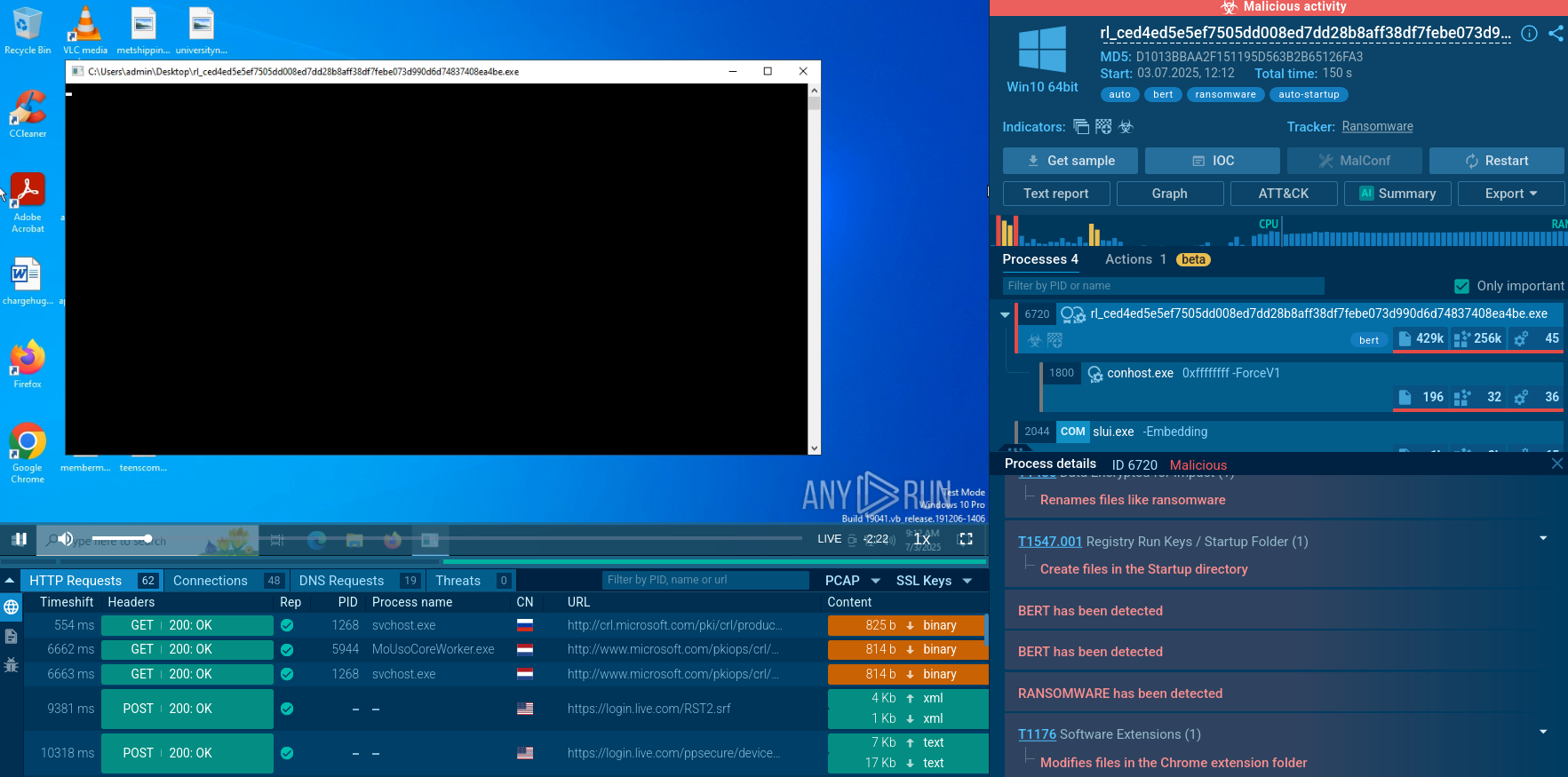 Bert Windows variant in the Interactive Sandbox
Bert Windows variant in the Interactive Sandbox
After launching the sample, the ransomware spawns child processes cmd.exe and PowerShell. Through the command line, it gathers system information (systeminfo, wmic), reads the machine GUID from the registry and OS installation date, executes whoami and net config workstation.
In PowerShell, commands are used to disable Windows Defender protection and firewall, as well as to add itself to the startup folder. It also uses processes reg.exe, rundll32.exe, schtasks.exe, and attrib.exe: the first two are used to modify registry and UAC, schtasks creates a task in the scheduler, and attrib hides the payload directory.
Additionally, Bert initiates renaming of user files and adds several extensions such as: *.encryptedbybert, *.encryptedbybert3, *.encryptedbybert11, *.encrypted_bert, *.hellofrombert, and creates the ransom note note.txt.
View Linux variant sandbox detonation
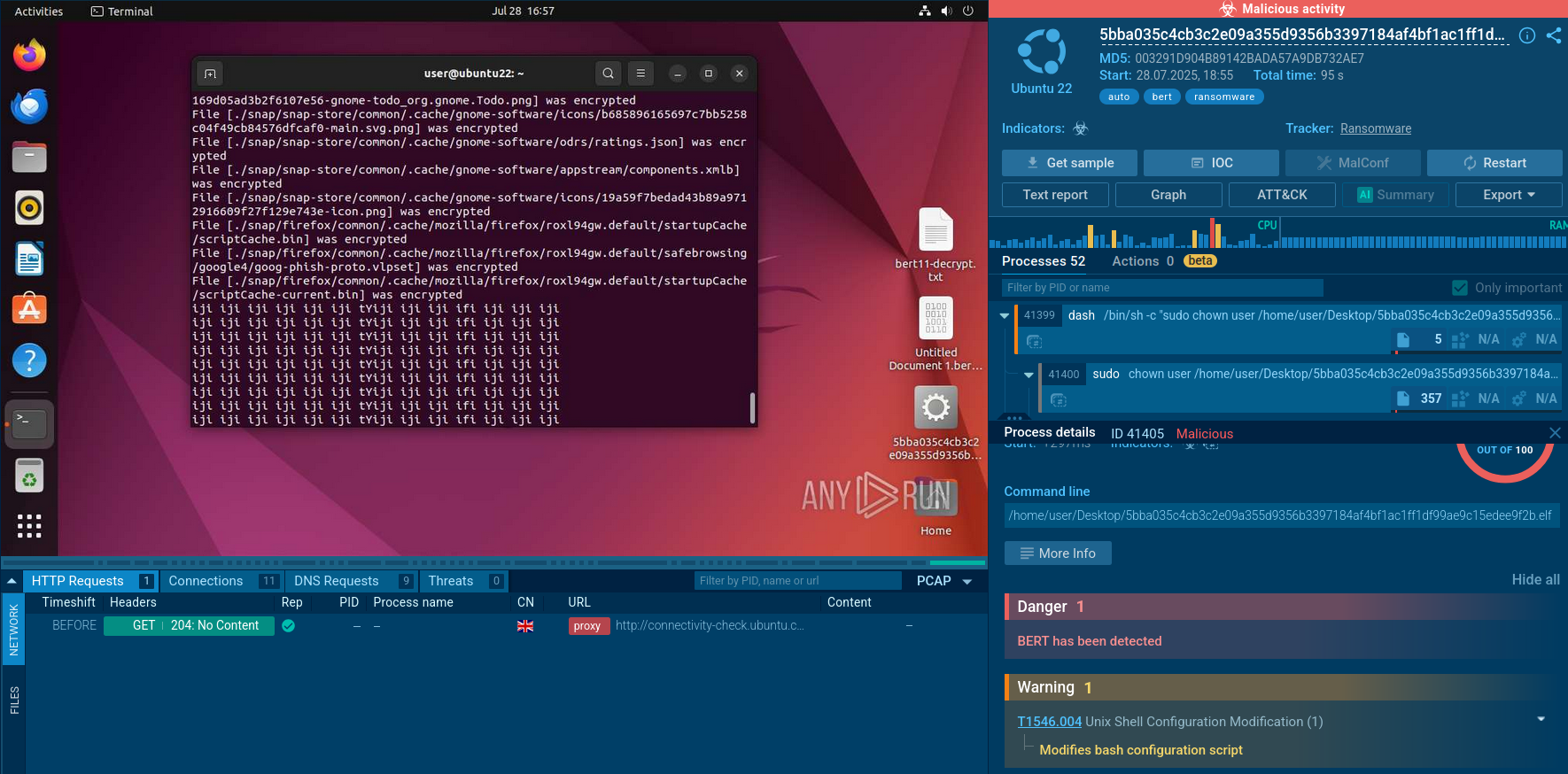 Bert Windows variant in the Interactive Sandbox
Bert Windows variant in the Interactive Sandbox
The ransomware executable is launched through the /bin/sh shell. First, it uses a chain of commands to obtain necessary privileges and launch itself:
/bin/sh -c "sudo chown user ... && chmod +x ... && DISPLAY=:0 sudo -i ..." - this is a sequential call of sudo chown to change file ownership to a regular user, chmod +x to grant execution rights, and then sudo -i to run the same file as superuser.
Separate calls to sudo chown user
After initiation, Bert gathers system information through standard utilities: uname –a and hostname are called through the chain sh -c "uname -a && echo " | " && hostname" to get kernel architecture and hostname.
This structure lists WorldIDs of virtual machines and closes them, as previously described regarding ESXi VM shutdown behavior.
During encryption, it adds one of the extension variants, in this case *.bert11, and drops the ransom note bert11-decrypt.txt, as well as displays a banner with the number of encrypted files in the console, including directories ~/.config/systemd/ and ~/.config/systemd/user; thus the program leaves ransom notes in each folder.
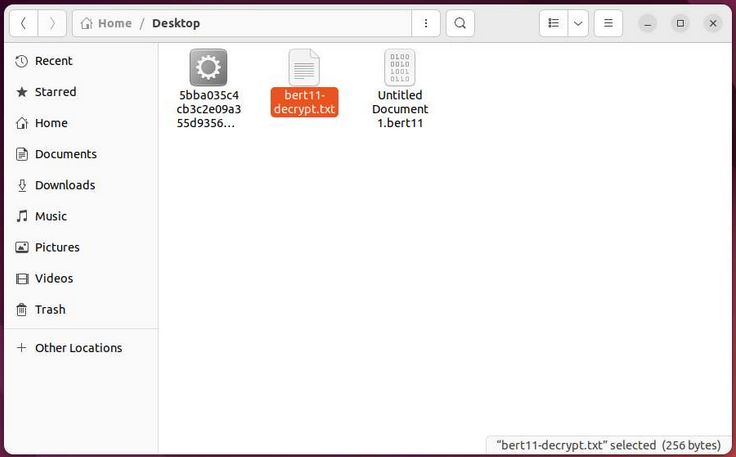 Bert ransom note on Linux endpoint
Bert ransom note on Linux endpoint
After launch, Bert analyzes the platform. On Linux/Linux servers, especially on ESXi hosts, it can identify running virtual machines and, if the --silent parameter is not set, forcibly shuts them down to prevent administrators from creating backups and quickly restoring the system.
On Windows, the loader script checks for administrative rights and restarts itself with elevated privileges, then copies the payload to disk and registers itself in startup through the task scheduler.
For unimpeded execution of malicious actions, the Windows variant of Bert modifies the registry to disable Windows Defender and its real-time protection, stops WinDefend and Sense services, deactivates the firewall, and reduces UAC level to zero. Then it downloads the main ransomware program from a remote IP address and runs it as administrator.
The Linux version embeds configuration in a JSON file and accepts command-line parameters to specify directory and number of encryption threads, providing flexibility and high performance (up to 50 threads).
Before encryption, Bert terminates processes that could interfere with the attack: on Windows - database and virtualization services, on Linux - running ESXi virtual machines. Then parallel encryption begins: on Windows, modern versions use ConcurrentQueue structure and create a separate thread for each volume to immediately process files, while on Linux/ESXi up to 50 threads are used. For encryption, RSA and AES are used on Windows, and a combination of AES, RC4, Salsa20, and ChaCha on Linux.
A ransom note is placed in each folder, and encrypted file names receive characteristic extensions like .encryptedbybert or .encrypted_by_bert, accompanied by data exfiltration to remote servers for double extortion.
Threat intelligence plays a crucial role in defending against Bert Ransomware. It provides visibility into the tactics, techniques, and procedures (TTPs) of Bert’s operators. Security teams can:
Start from querying Threat Intelligence Lookup with a threat name. If you want to select Bert samples targeting only Windows or Linux environment, specify an OS with a search parameter:
threatName:"bert" and os:"22.04.2"
 Bert samples found via TI Lookup: watch behavior, gather indicators
Bert samples found via TI Lookup: watch behavior, gather indicators
The key to defending against Bert ransomware lies in understanding that this is not merely a technical problem requiring technical solutions, but a comprehensive risk management challenge that affects every aspect of organizational operations. The ransomware's impact extends far beyond encrypted files to encompass business continuity, financial stability, regulatory compliance, and organizational reputation. Organizations must adopt a holistic defense approach that combines technical security controls, employee training, incident response planning, and threat intelligence integration.
The multi-platform nature of BERT ransomware means that defensive strategies must account for both Windows and Linux environments, while the group's sophisticated attack methods require advanced detection and response capabilities.
Start gathering actionable threat intelligence on Bert by sign up for ANY.RUN’s TI Lookup: protect your business with timely detection and response.
